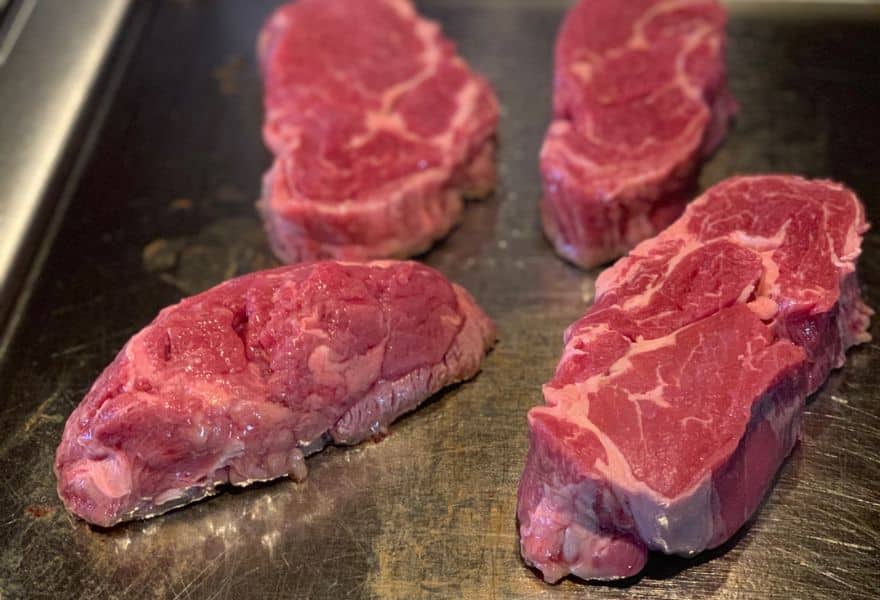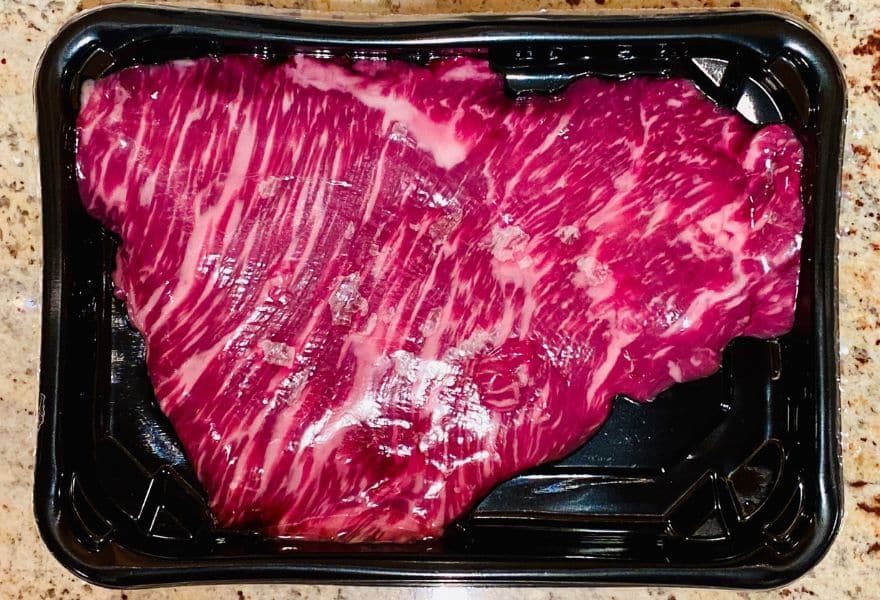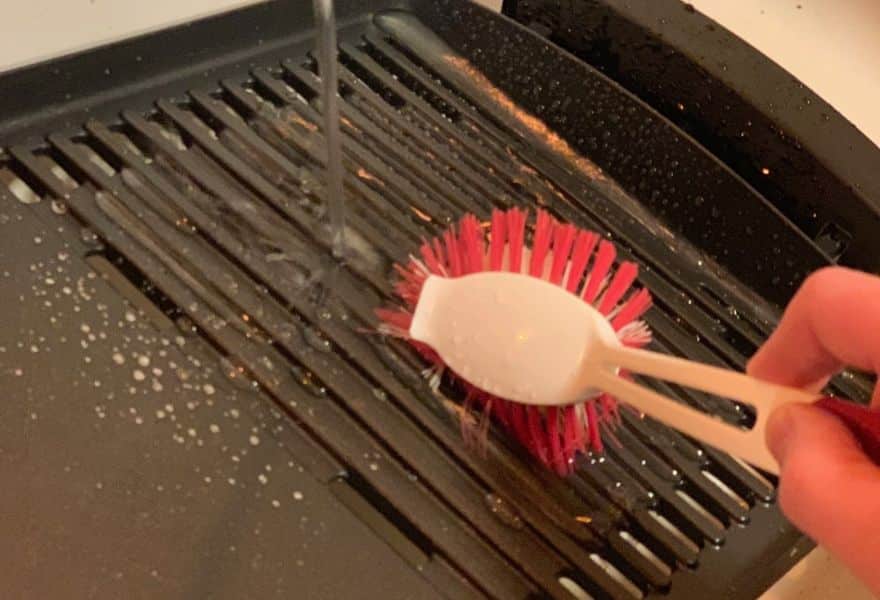Sometimes the biggest challenge when grilling is not the food you prepare for your guests, but the cleaning of the grill plates afterwards. And although a Teppan grill is a low-fat table grill, you can’t avoid cleaning it. In this article I would like to show you tips and tricks on how you can restore your Teppanyaki grill to perfect condition by cleaning it properly.

Why is it so important to clean a teppanyaki grill regularly?
Whether you are preparing burgers, fish, meat or other teppanyaki dishes, you should always remember to clean your grill regularly. As the grill plate is often exposed to high temperatures, residues from meals, fats, juices and other food residues stick to the grill surface of the teppan grill. If these grease and dirt residues are not cleaned and accumulate, a rubbery, often bacteria-laden layer forms. This chars easily at high temperatures. Once the residue is charred, it is very difficult to remove and unsightly discoloration remains. This charred mass also acts as a heat damper and causes the food to cook unevenly and taste strange.
There are various signs that your teppan grill is in urgent need of cleaning:
Food is sticking to the grill
Grease build-up on the grilling surface
The grill is discolored
Flavor transfer between foods
Uneven cooking of the food
How to clean your teppanyaki grill between two cooking phases
If you prepare very different types of food on your Teppan Grill, it is sometimes advisable to clean the grill between the different grilling phases. To do this, first remove any cooking residue from the grill plate with a spatula. Then hold the stainless steel spiral under cold running water using grill tongs and clean the grill plate with the damp spiral. Thanks to these simple steps, your teppan grill is ready for the next round. At the end of each grilling session, you must also wash and disinfect the drip tray of your Teppan Grill and then polish the front with kitchen paper.
Cleaning a teppanyaki grill
Teppan grills are made of either stainless steel or chrome steel. Most restaurants and fast food chains use teppanyaki grills and standard stainless steel grill plates. Other chefs, however, prefer to use chrome-plated grills as they have better heat retention. I will therefore describe the cleaning of both types of grill separately below.
Cleaning chrome-free steel plates
Use a grill scraper to wipe excess food and grease off the grill surface. Push the leftover food into the collection containers of the teppanyaki table grill and throw it away. This is the least you should do after every grilling process. Sometimes the steel plates are soiled with burnt food residue, which you need to rub off the grill plate with a scouring stone. Do this carefully so that you do not damage it.
Then clean its grilling surface with a non-abrasive grill cleaner and a kitchen towel. Now wipe the entire teppanyaki grill thoroughly clean with water, leave it to dry and prepare it for the next day. Remember that you must not spray the teppan grill with rust inhibitors, otherwise you will poison your guests. It is sufficient to apply a thin layer of cooking oil to the entire grill surface to prevent rust from accumulating on your grill. I generally recommend that you carry out weekly preventive maintenance and always allow the barbecue to cool down for at least 5 hours before cleaning.
Cleaning teppanyaki grills with a chrome surface
First remove excess grease and food residue with a grill scraper. Then wipe the surface of the grill clean with a damp paper towel. Scrape the food residue off the surface of the grill. Clean the grill plates with a kitchen towel and a mixture of soap and washing-up liquid. Clean the surface of the teppan grill again with a clean, dry kitchen towel after you have rinsed it to remove the cleaning mixture along with the dirt.
As chrome is somewhat more sensitive than stainless steel, I therefore recommend that you never use abrasive cleaners, pumice stone, a spatula or anything with sharp edges when cleaning. The same applies to steel wool and liquid grill cleaners that have been chemically prepared.
Cleaning the glass ceramic
If you have a Jaksch grill with a glass ceramic grilling surface, for example, you should wipe it with a suitable sponge or damp kitchen paper. There are also special scrapers for glass ceramic that you can use to remove stubborn residues afterwards. Now clean the grilling surfaces with a cleaning agent specially designed for glass ceramic and a kitchen towel or kitchen paper and dry them thoroughly.

Further tips and tricks for maintaining your teppanyaki grill
In most cases, teppanyaki grills are used to prepare meals for customers. In this case, there is really no choice but to clean them daily and maintain them weekly. However, if you are using the teppan grill for private dinners and parties, then the recommended cleaning schedule may not apply to you. The following tips will help you to significantly increase the lifespan of your teppanyaki grill:
Clean the drip pans and burners: most gas-fired teppan grills have drip pans for food residue and grease. I recommend that you always clean this container first before you start working on the grill plates. If you clean the table grill from the bottom up, you will save yourself a lot of effort and keep the grill working at optimum performance. Check regularly whether the burners are clogged and clean these too to ensure a continuous supply of the heat needed to cook the food.
Beware of the temperatures: If you really need to clean your teppanyaki grill while it is still red hot, use heat-resistant gloves and tools so that you don’t accidentally burn your hands or arms.
Use high temperature cleaners: There are non-toxic, liquid cleaning solutions specifically for teppanyaki grill plates that can be used at high temperatures. This means that you can use it even when the grill burner is on. As a rule, these cleaning agents work quickly, so you can start cooking again in no time at all.
Diligence pays off: The quicker and more regularly you clean your teppan grill, the easier the cleaning process will be. If, on the other hand, you always wait a long time from cleaning to cleaning, the residues on the grill plate are much more difficult to remove.
Pro tip: If you don’t want to use commercially available cleaning agents to clean the grill, you can use lemon juice and vinegar instead. Both are excellent cleaning agents for high temperatures. The lemon juice also helps to counteract discoloration by applying it to the cold steel plates.

Summary
The teppanyaki grill is an excellent addition to your kitchen, as it offers you many ways to expand your menu. And even though the teppan grill is one of the healthiest table grills, it needs to be cleaned regularly. This is not only for aesthetic reasons, but also contributes to its lifespan and a tastier grilling experience. In addition to the tips listed above, I recommend that you always take a look at the manufacturer’s operating instructions to avoid mistakes and accidents. If you carry out my maintenance work and clean your Japanese table grill regularly, it will remain intact for years to come. This will save you having to buy a new appliance.